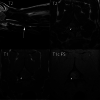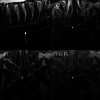Agreement and differentiation of intradural spinal cord lesions in dogs using magnetic resonance imaging
- PMID: 34859507
- PMCID: PMC8783334
- DOI: 10.1111/jvim.16327
Agreement and differentiation of intradural spinal cord lesions in dogs using magnetic resonance imaging
Abstract
Background: Magnetic resonance imaging is the method of choice for diagnosing spinal cord neoplasia, but the accuracy of designating the relationship of a neoplasm to the meninges and agreement among observers is unknown.
Objectives: To determine agreement among observers and accuracy of diagnosis compared with histology when diagnosing lesion location based on relationship to the meninges.
Animals: Magnetic resonance images from 53 dogs with intradural extramedullary and intramedullary spinal neoplasms and 17 dogs with degenerative myelopathy.
Methods: Six observers were supplied with 2 sets of 35 images at different time points and asked to designate lesion location. Agreement in each set was analyzed using kappa (κ) statistics. We tabulated total correct allocations and calculated sensitivity, specificity, and likelihood ratios for location designation from images compared with known histologic location for lesions confined to 1 location only.
Results: Agreement in the first set of images was moderate (κ = 0.51; 95% confidence interval [CI], 0.43-0.58) and in the second, substantial (κ = 0.69; 95% CI, 0.66-0.79). In the accuracy study, 180 (75%) of the 240 diagnostic calls were correct. Sensitivity and specificity were moderate to high for all compartments, except poor sensitivity was found for intradural extramedullary lesions. Positive likelihood ratios were high for intradural extramedullary lesions and degenerative myelopathy.
Conclusions and clinical importance: Overall accuracy in diagnosis was reasonable, and positive diagnostic calls for intradural extramedullary lesions and negative calls for intramedullary lesions are likely to be helpful. Observers exhibited considerable disagreement in designation of lesions relationship to the meninges.
Keywords: MRI; canine; interrater agreement; neoplastic; spinal cord.
© 2021 The Authors. Journal of Veterinary Internal Medicine published by Wiley Periodicals LLC on behalf of American College of Veterinary Internal Medicine.
Conflict of interest statement
Authors declare no conflict of interest.
Figures


Similar articles
-
Evaluation of magnetic resonance imaging for the differentiation of inflammatory, neoplastic, and vascular intradural spinal cord diseases in the dog.Vet Radiol Ultrasound. 2017 Jul;58(4):444-453. doi: 10.1111/vru.12501. Epub 2017 Apr 18. Vet Radiol Ultrasound. 2017. PMID: 28421647
-
Imaging diagnosis--spinal cord histiocytic sarcoma in a dog.Vet Radiol Ultrasound. 2015 Mar-Apr;56(2):E17-20. doi: 10.1111/vru.12135. Epub 2014 Jan 2. Vet Radiol Ultrasound. 2015. PMID: 24382300
-
Magnetic resonance imaging findings of an intradural extramedullary hemangiosarcoma in a dog.J Vet Med Sci. 2019 Oct 24;81(10):1527-1532. doi: 10.1292/jvms.19-0260. Epub 2019 Sep 4. J Vet Med Sci. 2019. PMID: 31484834 Free PMC article.
-
Intramedullary tumours and tumour mimics.Clin Radiol. 2020 Nov;75(11):876.e17-876.e32. doi: 10.1016/j.crad.2020.05.010. Epub 2020 Jun 23. Clin Radiol. 2020. PMID: 32591229 Review.
-
Extradural causes of myelopathy.Semin Ultrasound CT MR. 1994 Jun;15(3):226-49. doi: 10.1016/s0887-2171(05)80073-3. Semin Ultrasound CT MR. 1994. PMID: 8060674 Review.
Cited by
-
Common Neurologic Diseases in Geriatric Dogs.Animals (Basel). 2024 Jun 10;14(12):1753. doi: 10.3390/ani14121753. Animals (Basel). 2024. PMID: 38929372 Free PMC article. Review.
-
Case report: Magnetic resonance imaging features with postoperative improvement of atypical cervical glioma characterized by predominant extramedullary distribution in a dog.Front Vet Sci. 2024 May 22;11:1400139. doi: 10.3389/fvets.2024.1400139. eCollection 2024. Front Vet Sci. 2024. PMID: 38840642 Free PMC article.
-
PRO-QOL after gross total resection of spinal ependymoma: a retrospective study based on 3-year follow-up observations in a single center.Eur Spine J. 2025 Feb;34(2):665-674. doi: 10.1007/s00586-024-08601-2. Epub 2024 Dec 10. Eur Spine J. 2025. PMID: 39653854
References
MeSH terms
LinkOut - more resources
Full Text Sources
Medical

